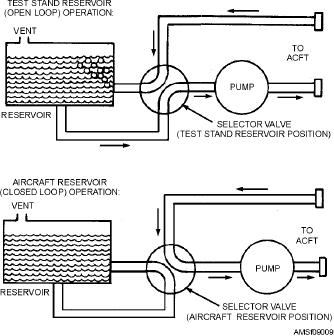
sight glass throughout the cleaning cycle to eliminate
reservoir is preferred because the vented reservoir
allows aircraft fluid deaeration during system
visible indications of entrapped air.
operation (fig. 9-9). Use this mode whenever practical.
When recirculation cleaning and deaeration are
When a test stand is equipped with return line,
complete, analyze the hydraulic fluid for
back pressure reducing valves, test stand reservoir
contamination. Terminate the fluid flow to the external
operation can be used even in situations where the
service hoses in preparation for connecting them to the
aircraft reservoir is normally used. Adjust the back
aircraft. Disconnect the service hoses from manifold
pressure reducing valve by presetting the value
assembly and reinstall the manifold dust covers.
equivalent to normal aircraft reservoir pressure.
Applying Hydraulic Power
Make sure that the aircraft controls are in the
s p e c i fi e d g r o u n d c h e c k p o s i t i o n s r e q u i r e d f o r
Before you connect a test stand to an aircraft
obtaining normal reservoir fluid level. Apply external
system, make sure that all personnel, workstands, and
hydraulic power and trim the back pressure reducing
other ground-handling equipment are clear of flight
valve until a stable, proper fluid level is obtained in the
control surfaces, movable doors, and other units. Stay
aircraft reservoir. Periodically check the fluid level.
clear of these areas when either electric power or
Ensure back pressure reducing valve is set properly or
hydraulic pressure is applied to the aircraft. Sudden
the aircraft may be damaged by overpressurization.
movement can cause injury or damage.
After you have adjusted the back pressure reducing
NOTE: Refer to the applicable maintenance
valve, you can start the test stand, and allow it to warm
manual for the specific procedures to follow when
up with the controls set for bypass fluid flow. Adjust
applying external electric and hydraulic power.
the flow rate and operating pressures to the required
values using the volume and pump compensator
Before connecting the hydraulic test stand to the
controls. Set the emergency relief valve (if so
aircraft, set the test stand controls to the positions and
equipped) to the operating pressure, plus 10 percent.
values required to accomplish the aircraft tests.
The bypass control should be fully closed during
Operate the test stand to confirm the settings. Reduce
aircraft operation. Adjust the operating pressure
the volume adjustment to minimum flow and shut
using the pump compensator control only. The test
down the stand. Connect the test service hoses to the
stand is now ready to power the aircraft hydraulic
aircraft ground power quick-disconnects, making sure
system.
that all connectors are clean before connection. Mate
all the attached dust caps and plugs to protect against
N OT E : U s e t h e p r o c e d u r e s f o u n d i n t h e
their contamination during test stand operation.
applicable MIM to actually power the aircraft
hydraulic system.
Do not kink or damage the test stand hose when
connecting it to an aircraft system. Keep the hose
uniformly bent while bending around structures or
equipment. Maintain and follow the recommended
minimum inside bend radius for the hose. A 1/2-inch
pressure hose should have a 2.30-inch radius, a
5/8-inch pressure hose a 5.37-inch radius, and a 1-inch
hose a 5.90-inch radius.
Before you can apply hydraulic power, you need to
check the aircraft reservoir level. Fill it to the level
specified in the applicable MIM or MRC. If necessary,
service the reservoir using an approved fluid service
unit. Then, set up the test stand for either aircraft or test
stand reservoir operation, as specified in the applicable
MIM. You can set the required mode of operation by
using the reservoir selector valve on stands that have
this equipment, or use the reservoir fluid supply valve.
When the test stand reservoir supply valve is closed,
Figure 9-9.--Test stand operating modes.
the aircraft reservoir will operate. The test stand
9-13

